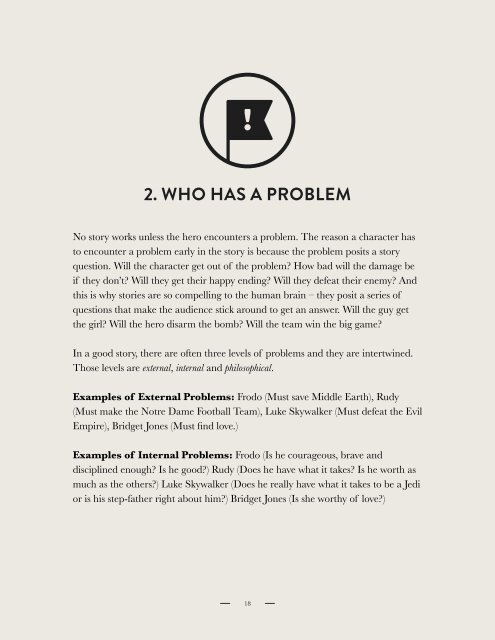Create successful ePaper yourself
Turn your PDF publications into a flip-book with our unique Google optimized e-Paper software.
2. WHO HAS A PROBLEM<br />
No s<strong>to</strong>ry works unless the hero encounters a problem. The reason a character has<br />
<strong>to</strong> encounter a problem early in the s<strong>to</strong>ry is because the problem posits a s<strong>to</strong>ry<br />
question. Will the character get out of the problem? <strong>How</strong> bad will the damage be<br />
if they don’t? Will they get their happy ending? Will they defeat their enemy? And<br />
this is why s<strong>to</strong>ries are so compelling <strong>to</strong> the human brain – they posit a series of<br />
questions that make the audience stick around <strong>to</strong> get an answer. Will the guy get<br />
the girl? Will the hero disarm the bomb? Will the team win the big game?<br />
In a good s<strong>to</strong>ry, there are often three levels of problems and they are intertwined.<br />
Those levels are external, internal and philosophical.<br />
Examples of External Problems: Frodo (Must save Middle Earth), Rudy<br />
(Must make the Notre Dame Football Team), Luke Skywalker (Must defeat the Evil<br />
Empire), Bridget Jones (Must find love.)<br />
Examples of Internal Problems: Frodo (Is he courageous, brave and<br />
disciplined enough? Is he good?) Rudy (Does he have what it takes? Is he worth as<br />
much as the others?) Luke Skywalker (Does he really have what it takes <strong>to</strong> be a Jedi<br />
or is his step-father right about him?) Bridget Jones (Is she worthy of love?)<br />
18



